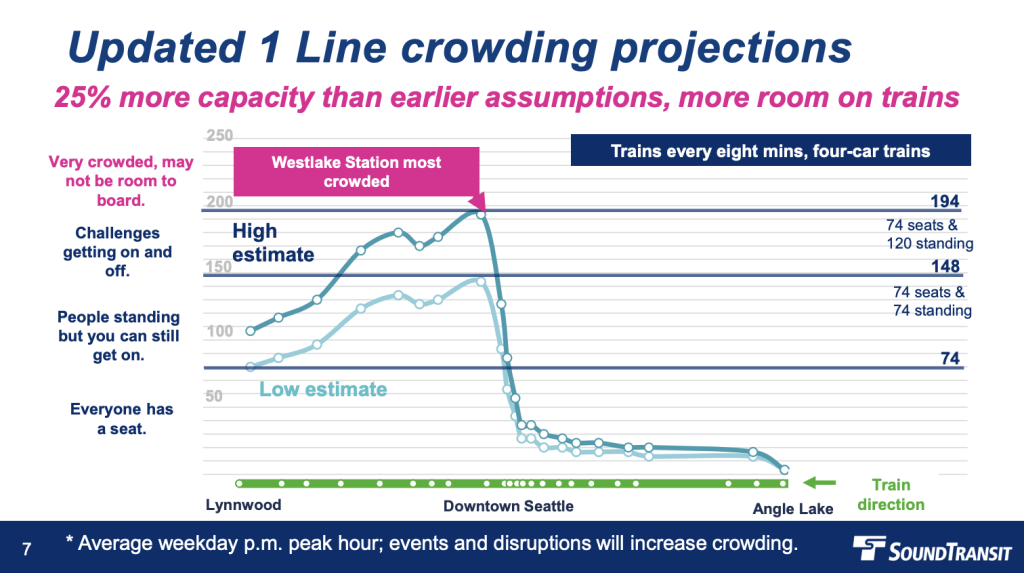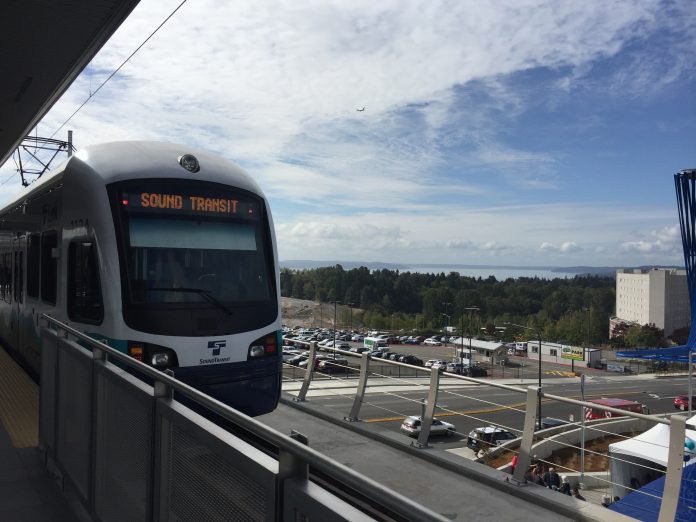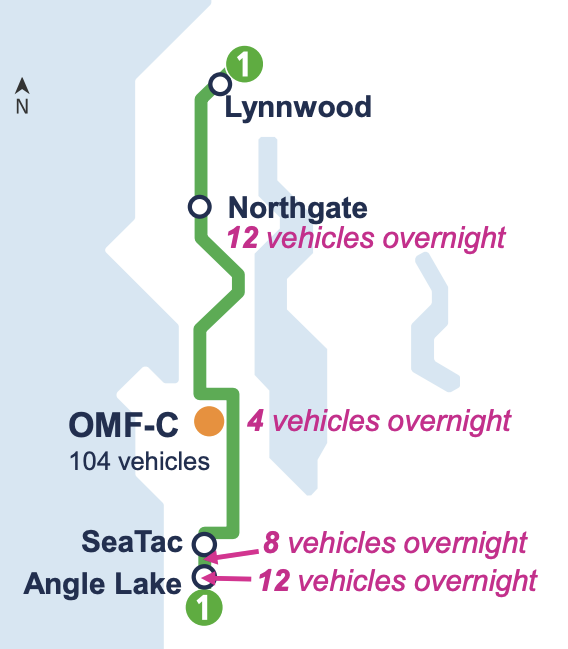When the Lynnwood Link Extension opens later this year, service levels are expected to be better than projected by Sound Transit planners last fall thanks to a plan to stash additional trains at elevated stations overnight. It’s genuinely good news for riders, but to do it there will be more near-term pain for riders to prepare the fleet.
On Thursday, agency staff told the board members at the Rider Experience and Operations Committee meeting that the improved peak-hour service levels are being made possible by more overnight storage of light rail vehicles (LRVs) along the 1 Line corridor. An extra 36 LRVs will find overnight storage at three stations and the Operations and Maintenance Facility Central (OMF-C), with 12 LRVs at Northgate and Angle Lake stations each, eight LRVs at SeaTac/Airport station, and four LRVs at OMF-C.
With extra vehicles on hand, Sound Transit will be able to improve frequencies to every eight minutes during weekday peak hours using four-car trains. Last fall, the agency had forecast service levels closer to every ten minutes during weekday peak hours with some trips only having three-car trains. Officials warned that would likely translate to crowding issues on trains.
The near-term train shortage issue stems in part from not having access to Operations and Maintenance Facility East’s storage capacity in Bellevue until East Link fully opens across Lake Washington in 2025, connecting the 2 Line into the network.
Beyond higher operating frequencies, another upshot is that post-Lynnwood Link capacity will be 25% higher than anticipated last fall. That means there should be more room on trains, though heavy crowding is still projected during peak hours, which could make it difficult to get on and off trains. Last fall, the agency had projected even more severe crowding, which would have left some riders at platforms during peak weekday hours in Seattle.

However, there will be some service reductions, starting late this month as part of the spring service change so that more vehicle maintenance can be conducted and so that vehicles require less maintenance due to less mileage. Service reductions will happen during evenings around 8:00pm, lowering frequencies from every ten minutes to every 12 minutes. Along with this, the agency will slightly adjust the start and end of service and implement some variability in train lengths with three- and four-car trains.
This planned service strategy will be stretching OMF-C’s design capacity by about 35%. As a consequence, riders may still notice some other regrettable impacts to service. That could involve some variability in train lengths when not enough vehicles can be put into service, longer recovery periods after service disruptions triggering uneven headways, and less clean vehicles since the agency will be trying to take trains out of service less often and is saying it will prioritize safety-related maintenance when it does. Sound Transit may also adapt its fleet deployment to adjust to ridership trends, altering when longer trains go into service.



George McGinn, an agency operations director, said on Thursday that the strategy of storing trains at stations overnight instead of OMF-C should be relatively secure, reducing the risk of vandalism. All of the stations chosen for storage are elevated, so the only easy access to them is through the stations themselves. That should offer a high level of security to vehicles since the stations are fully secured at the end of service and monitored by security personnel. McGinn also said that operators and maintenance staff will be coordinating security and have a presence in evenings. In fact, during this period maintainers will service trains at night so that they’ll be ready for the morning, according Brian de Place, a service planner.
Nevertheless, the service levels coming this fall are still considerably lower than Sound Transit originally planned before the 2 Line’s full opening was delay. The plan had been to offer four-minute combined frequencies between the 1 Line and 2 Line from Lynnwood City Center station to International District/Chinatown station. Unfortunately, construction defects along the I-90 corridor has delayed full opening of the 2 Line.
Thus, Sound Transit plans to continue with its interim ST Express bus augmentation strategy to be implemented later this year to support opening of the Lynnwood Link Extension. That involves deploying some redundant ST Express service between Lynnwood and Downtown Seattle to take pressure off of the 1 Line.
A new ST Express service will run as Route 515 during weekday peak periods in the peak direction every 10 minutes between Lynnwood and Downtown Seattle. Route 510 will also be retained to provide similar service but maintaining the route all the way to Everett with service during weekday peak periods in the peak direction every 15 minutes.


On top of this, the agency plans to trim Routes 512 and 513 back by eliminating their southern tails to Northgate station. Service will therefore be truncated to Lynnwood with Route 512 operating all the way to Everett and Route 513 operating to the Seaway Transit Center. Route 512 will operate as frequently as every 15 minutes in both directions all days of the week and Route 513 will operate only on weekdays during peak periods in the peak direction every 30 minutes.
Later in 2025, the full 2 Line is supposed to be opened. Interim CEO Goran Sparrman said on Thursday that corrective work on defective plinths is going about to schedule with more than 60% of them fully replaced. An agency progress report published this month forecasts a revenue service start date on October 8, 2025 — last month’s report forecasted a November 2025 date.
However, Sparrman did flag that the agency isn’t fully confident that the target schedule will be met, which may be reasonable given the variability in progress. He suggested that while there is risk of further schedule slippage, he believed that the full 2 Line should be opened by late 2025. So Link 1 Line riders should expect a service pinch for a bit more than a year with some of the effects beginning later this month.
Stephen is a professional urban planner in Puget Sound with a passion for sustainable, livable, and diverse cities. He is especially interested in how policies, regulations, and programs can promote positive outcomes for communities. With stints in great cities like Bellingham and Cork, Stephen currently lives in Seattle. He primarily covers land use and transportation issues and has been with The Urbanist since 2014.



